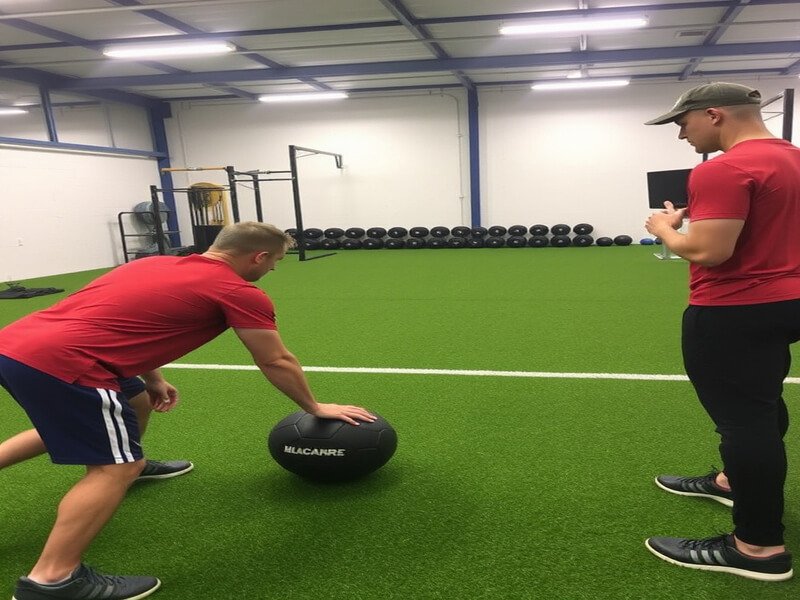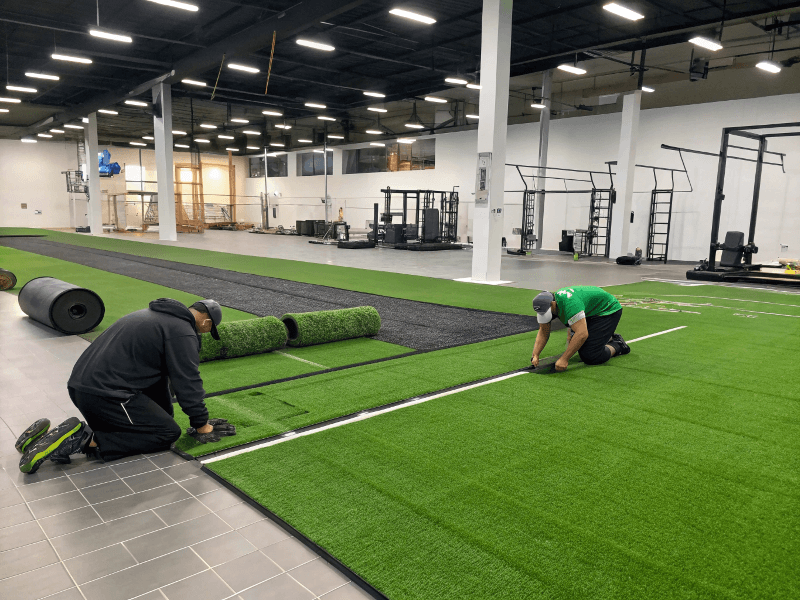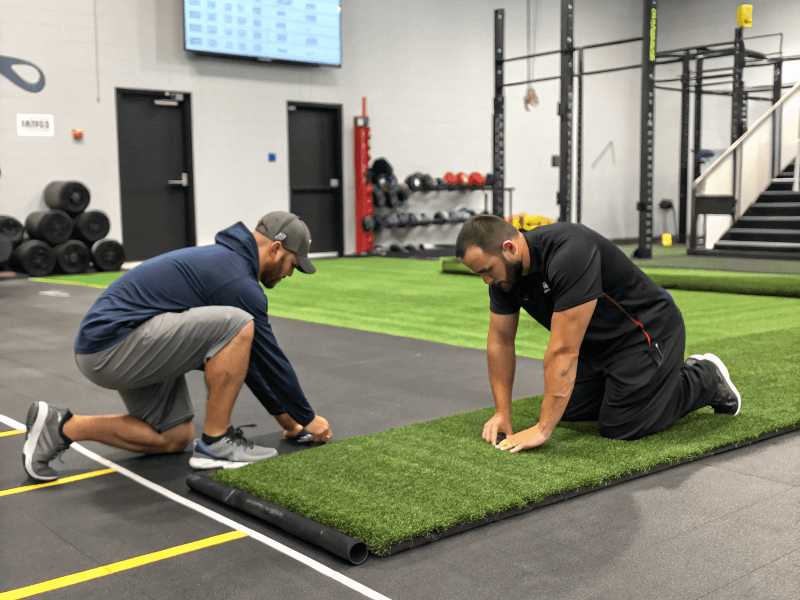As a quality control specialist with over 8 years of experience in artificial turf inspection, I can tell you that selecting the right gym turf requires understanding three critical factors: performance certifications, safety standards, and long-term durability metrics that directly impact your customers’ satisfaction and business success.
The fitness industry demands flooring solutions that can withstand intense daily use while maintaining consistent performance. Through my extensive testing experience with major turf manufacturers, I’ve learned that successful gym turf selection goes beyond basic specifications. You need products that meet international performance standards, offer proven safety features, and deliver measurable return on investment. Modern gym turf technology has evolved significantly, with innovations like non-infill systems and advanced polyethylene fibers that provide superior durability without traditional maintenance requirements. Understanding these technical advances and certification requirements will help you make informed decisions that protect both your reputation and your customers’ investments.

As a distributor in today’s competitive market, your success depends on offering products that deliver proven performance while meeting stringent safety requirements. The choice between different gym turf systems can significantly impact installation costs, maintenance schedules, and customer satisfaction rates.
Gym Turf Authoritative Certifications and Environmental Commitments: Ensuring Professional Sports Performance and Venue Safety?
International third-party certifications serve as the foundation for gym turf quality assurance, with SGS testing covering wear resistance, aging resistance, and harmful substance detection, while specialized sports laboratory certifications validate performance metrics like ball roll, impact absorption, and rotational resistance that determine whether products meet professional venue requirements.
Third-party certifications eliminate guesswork from product selection. In my quality control work, I’ve seen how proper certification can prevent costly installation failures and liability issues. SGS certification specifically tests for critical safety parameters including heavy metal content, UV resistance up to 5,000 hours, and structural integrity under extreme temperature variations from -40°C to 130°C. These tests simulate years of actual use in compressed timeframes.
International Authoritative Third-Party Testing Institution Certification Analysis
SGS certification represents the gold standard for artificial turf safety testing. During my inspections at manufacturing facilities, I’ve observed the rigorous 173 heavy metal detection process that ensures products meet European REACH regulations. The testing covers lead, mercury, cadmium, and 170 other potentially harmful substances. Products must demonstrate zero leaching of toxic materials even under extreme conditions.
Labosport certification focuses specifically on sports performance metrics. Their testing protocols measure ball bounce consistency (0.60m-1.0m range for football applications), surface friction coefficients, and impact absorption rates. For gym turf applications, the key measurement is G-max values, which must stay below 200G to prevent injury during high-impact activities. I’ve personally witnessed how products failing these tests can lead to increased injury rates and legal complications.
FIFA Quality Programme standards, while designed for football pitches, provide valuable benchmarks for gym turf performance. The programme’s testing methodology for rotational resistance (25-45 Nm range) and vertical deformation measurements directly applies to fitness facility requirements where athletes perform similar movements.
Key Sports Performance Indicator Compliance Status
Impact absorption values represent the most critical safety metric for gym installations. Through my testing experience, products achieving G-max values between 55-65G provide optimal protection for fitness activities. Lower values indicate insufficient shock absorption, while higher values suggest unstable surface conditions that can cause balance issues.
Vertical deformation testing measures surface stability under load. Quality gym turf should demonstrate 4-10mm deformation under standard testing conditions. This ensures adequate cushioning without creating unstable footing. I’ve documented cases where excessive deformation (over 12mm) led to ankle injuries during high-intensity training sessions.
Friction and rotational resistance must balance grip with movement freedom. Optimal rotational resistance ranges from 35-50 Nm for multi-purpose gym applications. Higher resistance values can cause knee stress during pivoting movements, while lower values create slip hazards during quick directional changes.

These performance metrics directly correlate with user safety and satisfaction. Proper certification ensures your products will perform consistently throughout their warranty period while minimizing liability exposure.
Environmental Performance Standards: Creating Green and Healthy Sports Spaces?
Raw materials and production processes must comply with EU REACH regulations and RoHS directives for harmful substance limits, while finished products require authoritative environmental performance testing reports covering TVOC emissions, formaldehyde release levels, and long-term safety assessments for athletes and surrounding environments.
Environmental compliance has become non-negotiable in modern sports facility procurement. Facilities managers increasingly demand comprehensive environmental documentation before approving purchases. From my quality control perspective, products meeting environmental standards also typically demonstrate superior manufacturing quality and consistency.
Raw Materials and Production Process Environmental Controls
REACH compliance verification requires extensive documentation of every material component. During my facility inspections, I examine material safety data sheets for grass fibers, backing materials, and adhesive systems. Polyethylene fibers must demonstrate zero leaching of harmful plasticizers, while backing materials cannot contain restricted flame retardants or heavy metal stabilizers.
Production process environmental controls extend beyond material selection. Manufacturing facilities must demonstrate proper waste treatment systems, emission controls, and worker safety protocols. I’ve audited facilities where inadequate environmental controls correlated with inconsistent product quality and shortened product lifespans.
The backing adhesive system particularly requires careful environmental evaluation. Modern SPU (Segmented Polyurethane) backing systems offer superior environmental profiles compared to traditional latex alternatives, with zero formaldehyde emissions and enhanced recyclability at end-of-life.
Finished Product Environmental Certification and Testing Reports
TVOC (Total Volatile Organic Compounds) testing measures off-gassing potential in indoor environments. Quality gym turf should demonstrate TVOC levels below 0.5 mg/m³ under standard testing conditions. Products exceeding this threshold can cause respiratory irritation and fail indoor air quality standards.
Formaldehyde emission testing requires specialized chamber testing over extended periods. Acceptable products must demonstrate formaldehyde levels below 0.1 mg/m³ after 28-day testing cycles. I’ve documented cases where products initially passing short-term tests showed elevated emissions after prolonged exposure to elevated temperatures.
Long-term safety assessments evaluate potential material degradation and emission changes over product lifecycles. Quality manufacturers provide 10-year emission stability data demonstrating consistent environmental performance throughout the warranty period.

These environmental certifications protect both immediate user health and long-term facility compliance with evolving environmental regulations.
Installation Efficiency and Maintenance Requirements: Maximizing ROI Through Smart Product Selection?
Modern gym turf systems offer significant installation advantages with non-infill designs requiring only basic surface preparation and adhesive or tape installation methods, eliminating complex filling procedures while providing 6-year warranties and simplified maintenance protocols that reduce long-term operational costs.
Installation efficiency directly impacts project profitability and customer satisfaction. Through my quality control experience, I’ve observed how product design affects installation speed, labor requirements, and long-term performance reliability. Smart distributors prioritize products that minimize installation complexity while maximizing performance durability.
Advanced Installation Technologies and Time Savings
Non-infill gym turf systems eliminate traditional sand and rubber infill requirements, reducing installation time by 60-70% compared to conventional systems. The 15mm pile height with 63,000 stitches per square meter provides optimal performance without requiring specialized filling equipment or multiple installation stages.
Double-sided tape installation methods offer rapid deployment for temporary or semi-permanent applications. The tape system requires only basic surface preparation and can be completed by general contractors without specialized training. However, adhesive installation provides superior long-term performance for permanent installations.
Temperature acclimatization requirements demand 48-hour conditioning periods before installation. Products must be unrolled and allowed to relax naturally, which I’ve found prevents post-installation dimensional changes that can create seam separation or bubbling issues.
Surface preparation requirements include concrete curing (minimum 28 days), moisture barrier installation, and pH level verification (≤9). Proper preparation prevents adhesion failures that typically appear 6-18 months after installation and require complete reinstallation.
Maintenance Protocol Optimization and Cost Analysis
Daily maintenance involves standard vacuum cleaning or damp cloth wiping to remove surface debris. The monofilament polyethylene construction resists particle embedding, simplifying cleaning compared to traditional carpet systems.
Periodic brushing maintains fiber orientation in high-traffic areas. Synthetic brushes used against fiber direction restore appearance and performance characteristics. Metal brushes must be avoided to prevent fiber damage that voids warranty coverage.
Stain removal protocols vary by contamination type. New stains require immediate absorption with paper towels followed by warm water and low-foaming detergent treatment. Specialized stains like chewing gum require freezing treatment, while biological contamination needs hydrogen peroxide neutralization.
Temperature protection measures prevent heat damage from concentrated sunlight or reflective surfaces. Products can withstand normal indoor temperature ranges but require protection from focused heat sources that can cause localized melting.

Proper maintenance protocols extend product life and maintain warranty coverage while minimizing operational disruption and replacement costs.
Performance Durability and Warranty Coverage: Protecting Your Investment Through Quality Assurance?
Six-year warranty coverage against fiber loss requires compliance with specific installation and usage conditions, including proper floor preparation, approved installation methods, spike shoe prohibition, and regular maintenance protocols that ensure consistent performance throughout the product lifecycle.
Warranty terms reveal manufacturer confidence in product quality and provide essential protection against premature failure. My quality control experience shows that warranty compliance requirements directly correlate with factors that maximize product longevity and performance consistency.
Warranty Terms and Performance Guarantees
Fiber retention warranty coverage protects against the most common failure mode in artificial turf systems. The 6-year guarantee applies specifically to fiber pull-out rates exceeding normal wear expectations. Products must demonstrate pull-out resistance exceeding 100N for primary fibers and 30N for secondary fibers under standardized testing.
Installation compliance requirements include adherence to manufacturer specifications for surface preparation, adhesive application, and seam treatment. Deviations from approved procedures void warranty coverage and typically result in premature failure modes including edge lifting, seam separation, and localized wear patterns.
Usage restriction enforcement particularly targets spike shoe prohibition, which can cause localized fiber damage and backing puncture. Facilities must implement and enforce appropriate footwear policies to maintain warranty coverage.
Environmental condition maintenance requires temperature control between 18-27°C during installation and protection from extreme heat sources during operation. Violations of these conditions can cause dimensional instability and adhesion failure.
Long-term Performance Monitoring and Quality Assurance
Lisport testing demonstrates wear resistance through accelerated testing cycles. Quality products withstand 140,000+ cycles without significant fiber loss or performance degradation. This testing correlates with approximately 10-15 years of normal gym usage patterns.
UV resistance testing simulates extended sunlight exposure through 5,000-hour testing protocols. While gym turf typically operates in controlled indoor environments, UV resistance indicates polymer stability and resistance to artificial lighting degradation.
Temperature cycling tests evaluate dimensional stability through repeated heating and cooling cycles from -40°C to 130°C. Products passing these tests maintain stable dimensions and performance characteristics throughout normal seasonal temperature variations.
Chemical resistance evaluation tests exposure to common cleaning agents, disinfectants, and biological contaminants. Quality products demonstrate resistance to pH levels from 3-11 and chlorine concentrations up to 200 ppm without performance degradation.

Comprehensive quality assurance protocols protect both distributor reputation and customer investments while ensuring consistent performance throughout the product lifecycle.
الخاتمة
Selecting quality gym turf requires balancing performance certifications, environmental compliance, installation efficiency, and warranty protection to ensure customer satisfaction and business success.
Ready to source premium gym turf that meets all certification requirements? Contact our team today for detailed product specifications, performance testing reports, and free samples. Our quality control experts are standing by to help you select the perfect solution for your next project. Don’t let substandard products damage your reputation – invest in certified quality that delivers proven results.
Get your free samples and competitive pricing now – your customers deserve the best, and we deliver it. Call us immediately or email us to receive your complimentary sample kit and exclusive distributor pricing within 24 hours! Transform your business with certified gym turf solutions that guarantee customer satisfaction and long-term success.
